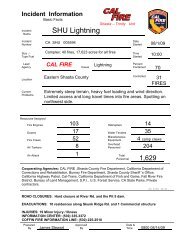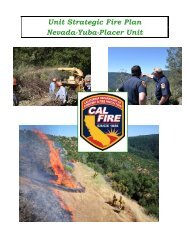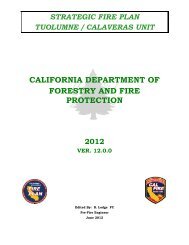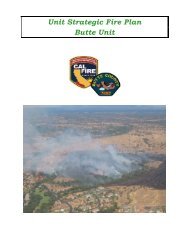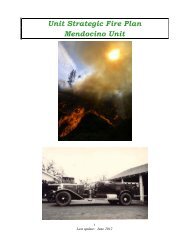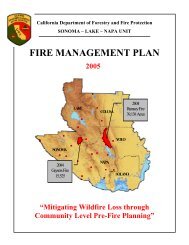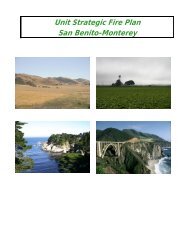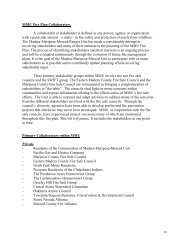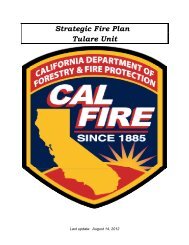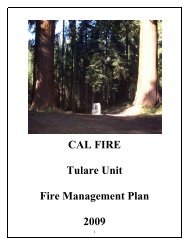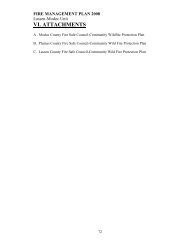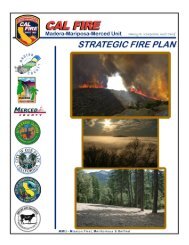Nevada-Yuba-Placer Strategic Fire Plan 2011 - Board of Forestry ...
Nevada-Yuba-Placer Strategic Fire Plan 2011 - Board of Forestry ...
Nevada-Yuba-Placer Strategic Fire Plan 2011 - Board of Forestry ...
Create successful ePaper yourself
Turn your PDF publications into a flip-book with our unique Google optimized e-Paper software.
APPENDICES D-Z<br />
APPENDIX D<br />
Standards for Hazardous Fuel Reduction in NEU<br />
Purpose/Overview<br />
The purpose <strong>of</strong> the development, implementation and maintenance <strong>of</strong> a project such as fuel<br />
modification can be considered a fire prevention/management tool that may promote<br />
awareness, mitigation, and assist in fire suppression activities in the event <strong>of</strong> a wildland fire<br />
situation in Interface Lands. The objective is to reduce, modify, and manage fuels within<br />
designated areas that may enhance mitigation efforts in the event <strong>of</strong> a wildland fire situation.<br />
The Shaded Fuel Break is an identified key component <strong>of</strong> any project:<br />
is a strategic location along a ridge, access road, or other location where fuels have<br />
been modified. The width <strong>of</strong> the fuel break is usually 100 to 300 feet depending on the<br />
site. This is a carefully planned thinning <strong>of</strong> dense vegetation, so fire does not easily<br />
move form the ground into the overhead tree canopy. A shaded fuel break is not the<br />
removal <strong>of</strong> all vegetation in a given area. <strong>Fire</strong> suppression resources can utilize this<br />
location to suppress wildland fires due to the modification <strong>of</strong> fuels <strong>of</strong> which may increase<br />
the probability <strong>of</strong> success during fire suppression activities. Any fuel break by itself will<br />
not stop a wildland fire.<br />
The Shaded Fuel Break is a recommended guideline for fuel management within identified<br />
Interface Lands.<br />
The goal is to protect human life and both public and private resources by reducing the risk and<br />
potential hazard <strong>of</strong> wildland fire by practicing management strategies that promote the<br />
preservation and restoration <strong>of</strong> natural resources and protection <strong>of</strong> cultural resources.<br />
Objectives are mitigation <strong>of</strong> fire dangers in an effort to: Enhance public safety; Protect natural<br />
and cultural resources; Provide for recreational opportunities; Conduct cost effective<br />
maintenance <strong>of</strong> features and facilities.<br />
In previous <strong>Fire</strong> <strong>Plan</strong>s, three separate fuel reduction prescriptions were described (Defensible<br />
Space, Defensible Landscape, and Modified Shaded Fuel Break). With the adoption <strong>of</strong> the new<br />
PRC 4291 standards, NEU is recommending landowners utilize the guidelines adopted<br />
statewide. Further, we recommend landowners utilize the “Defensible Space – Reduced Fuel<br />
Zone” guidelines for areas beyond the required 100 feet. These guidelines can be downloaded<br />
from the Internet at:<br />
http://www.b<strong>of</strong>.fire.ca.gov/pdfs/4291finalguidelines2_23_06.pdf<br />
124



